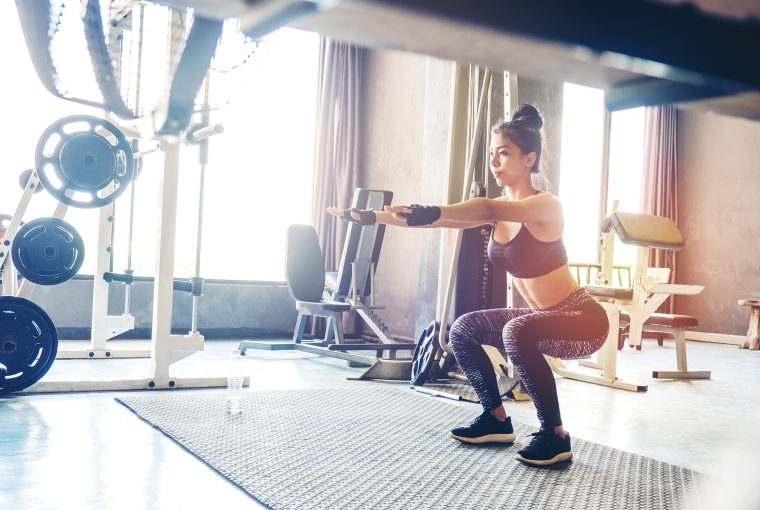Classic squats are one of the three best butt-toners around, according to ACE Fitness research. But if you don’t know how to do squats correctly, you aren’t making the most of this muscle-building move.
Check out these six super-common squatting mistakes and learn how to fix them for a better butt.
1. The Problem: Your shoulders and back are relaxed.
Without proper tension in your shoulders and back, your entire squat breaks down: You round your back, you lose control, and apart from being able to lift less weight, you also up your risk of injury, says Tony Gentilcore, C.S.C.S., a strength coach in Boston, Massachusetts. Basically, your body forgets how to do squats.
The Fix: Pull your shoulder blades down and together. This simple switch will engage your core and keep your body from becoming loosey-goosey, Gentilcore says. You’ll be shocked how much stronger you’ll feel. Plus, by squeezing your shoulder blades together, you create a little shelf on the back of your shoulders that’s perfect for a barbell. If you’re performing back squats (you have a barbell across the back of your shoulders), focus on pulling the bar into that little shelf. It’ll help you keep your shoulder blades tight throughout the entire movement, he says.
2. The Problem: Your knees fall toward each other.
Caved-in knees are a telltale sign that your outer thighs are lacking in strength, Gentilcore says. And if you let your knees cave in, you’ll only exacerbate muscular imbalances.
The Fix: Anchoring your feet to the floor can go a long way toward keep your knees where they need to be, he says. Take a “tripod” stance, making sure your weight is evenly distributed under your big toe, little toe, and heel. Then, pretend you’re trying to spread the floor between your feet. Push your feet into the ground and out to the sides. Your feet shouldn’t actually move, but you should feel some tension in your hips. That will give you some more stability so your knees don’t cave in, Gentilcore says.
3. The Problem: You never squat below parallel.
“There’s a big misconception that squatting below parallel is bad for your knees. That’s completely false,” Gentilcore says. “If you have no knee issues, squatting deep is perfectly healthy and can actually make knees stronger.” Plus, deep squats work parts of your glutes that shallow squats just don’t.
The Fix: Squat as low as you can comfortably. The ideal depth is going to be different for every woman. But, by and large, you should squat until the top surface of your thigh is just below your knee, Gentilcore says. Meanwhile, as long as you feel comfortable and in control, you can go even lower, says Nick Tumminello, owner of Performance University and author of Strength Training for Fat Loss. Just remember, squats should never hurt. If they hurt, that’s your body telling you to change how you’re doing them.
4. The Problem: You’ve only tried one type of squat.
Squats come in a all shapes and sizes-just like the women who perform them, says Gentilcore. You’ve got back squats, front squats, goblet squats, plyometric squats, the list goes on.
The Fix: Mix up your variations for maximum results. While every type of squat will do wonders for your lower body, each variation emphasizes different muscles, such as your hamstrings or glute medius, aka side butt. Hit a few variations every week and you’ll get the benefits of all of them, he says.
5. The Problem: You squat once a week.
The less often you squat, the longer it will take to see results, both in terms of sculpting muscle and blasting fat, Gentilcore says, even if you know exactly how to do squats perfectly. Squats are incredibly efficient: They work more muscles and burn more calories than just about any other movement.
The Fix: To find a happy medium between undertraining and overtraining, shoot to perform squats two to three times per week, he says. One day, lift heavy weights for only a handful of reps. One day, lift lighter weights for about a dozen reps. If you decide to add a third day in there, try a different squat variation, he says.
6. The Problem: Your knees extend way past your toes.
The farther your knees jut out past your toes, the more you stress your knee joints. If you have sensitive knees, that could spell injury, Tumminello says.
The Fix: Keep your knees in line with your toes. While it’s perfectly OK if your knees extend a centimeter or two in front of your toes, focusing on keeping them behind your toes is an easy way to make sure you don’t end up taking things too far forward, he says. “Ideally, your hips should move back just as much as your knees move forward,” Gentilcore says.




